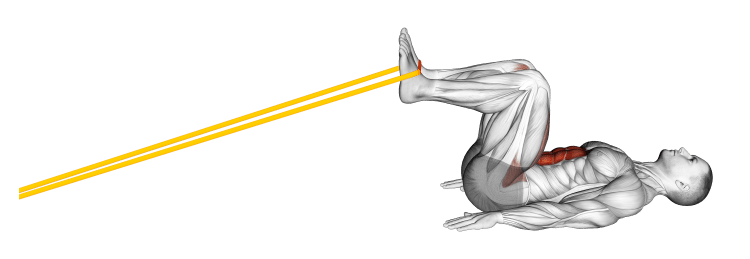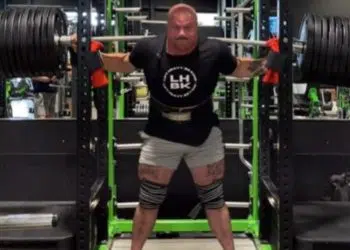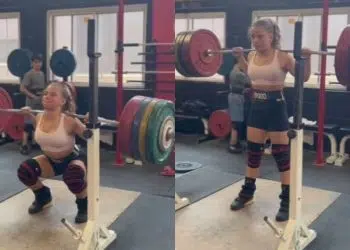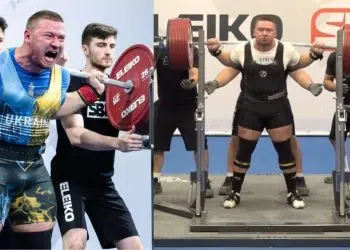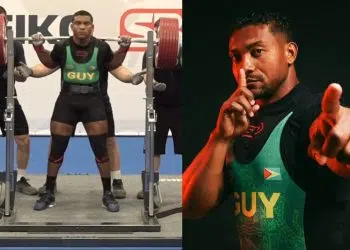A lot of trainers believe that squats, deadlifts, and other compound exercises are all you need for a stronger core. As such, they include few, if any, direct core exercises in their workouts.
However, I don’t agree.
During my 30-plus years working in the fitness industry, I’ve come to realize that the human body is only as strong as its weakest muscle group. Consequently, if your core is weak, the rest of your body will be weak, too.
As the saying goes, a chain is only as strong as its weakest link. Therefore, core training is a must, even if you squat hard, heavy, and often.
Science supports my point of view. In fact, one study published on PubMed compared core engagement during heavy squats and planks. The researchers found that planks produced more core muscle activation than squats (1).
That’s not to say all squat variations are ineffective for building core strength. The reverse squat is a particularly beneficial core exercise.
Level Up Your Fitness: Join our 💪 strong community in Fitness Volt Newsletter. Get daily inspiration, expert-backed workouts, nutrition tips, the latest in strength sports, and the support you need to reach your goals. Subscribe for free!
In this article, I reveal how and why to perform reverse squats and share some of my best tips and variations for this useful exercise.
Reverse Squat Correct Form
Get more from reverse squats while minimizing your risk of injury by following these step-by-step instructions:
- Attach abs-blaster straps to one of the low pulleys on a cable crossover machine. Alternatively, connect two ankle cuffs to your cable crossover machine.
- Sit on the floor and place the straps around your feet as close to your ankles as possible. Pull your toes up toward your shins.
- Extend your legs, shuffle backward, lie back, and grip the opposite weight tower. Your legs and body should be straight.
- Brace your core and press your lower back into the floor.
- Bend your legs and pull your knees into your chest. Really draw your knees up and out, just like you’re doing a deep squat.
- Extend your legs and repeat.
Reverse Squats: Muscles Worked
Reverse squats are a compound exercise. This means they involve multiple joints and work several muscles at once. The primary muscles trained during reverse squats are:
- Rectus abdominis
- Obliques
- Transverse abdominis
- Hip flexors
- Rectus femoris
- Hamstrings
- Adductors
Pro-Trainer Tips
Get more from reverse squats with these tried-and-tested pro-trainer tips.
- Warm up before working out. This exercise is more strenuous than it looks.
- Maintain a posterior pelvic tilt throughout. In other words, press your lower back into the floor.
- Pull your knees up explosively and then extend them under control to maximize muscle engagement.
- Inhale as you pull your knees in, and exhale as you extend your legs.
- Push your knees outward to engage your adductors and increase hip stability.
Reverse Squat Mistakes to Avoid
Make reverse squats as safe as possible by avoiding these common mistakes.
- Going too heavy too soon – master the movement before adding weight.
- Allowing your knees to cave in – push your knees apart as you pull them in toward your chest.
- Excessive lower back arching – while your lower back can move, avoid excessive arching, which puts undue stress on your lumbar spine.
- Ignoring pain – this exercise should be challenging but not painful. Stop your set if you feel pain, especially in your lower back.
- Doing this exercise too often – give your muscles the time they need to recover by only doing this exercise 2-3 times a week.
Reverse Squat Benefits
Not sure if reverse squats deserve a place in your workouts? Consider these benefits and then decide.
Increased core strength
Your core bridges the gap between your upper and lower body. A weak core means your midsection could collapse during exercises like squats, overhead presses, deadlifts, and push-ups.
Weighted reverse squats mean you can progressively increase the load on your core muscles, leading to increases in strength. This is not usually possible with unweighted core exercises.
A stronger core can improve athletic performance (2) and reduce the incidence of lower back pain (3).
Improved squat mechanics
The reverse squat teaches you how to engage your hip flexors and “pull” yourself down into a deeper squat. This is a critical skill that, once learned, will enhance squat mechanics. It also helps exercisers get a feel for doing deeper squats without doing the conventional movement.
Smart trainers also reverse squats to determine if their clients can do regular deep squats. If you can’t pull your knees to your chest without rounding your lower back on the floor, you probably won’t be able to do it while standing, either. Consequently, this exercise is often used as a screening exercise for standing squats.
Level Up Your Fitness: Join our 💪 strong community in Fitness Volt Newsletter. Get daily inspiration, expert-backed workouts, nutrition tips, the latest in strength sports, and the support you need to reach your goals. Subscribe for free!
Stronger hip flexors
Most abs and core exercises focus on the midsection muscles and ignore the hip flexors. That’s a shame because the core and hip flexors often work together, e.g., when kicking, running, or jumping. As such, reverse squats are a very functional core exercise as they mirror the demands of many everyday and athletic movements.
Better hip mobility
Reverse squats involve a large range of motion. Consequently, as well as strengthening your lower body, they can potentially increase your functional range of motion. However, unlike passive stretches, you are directly responsible for controlling the movements, so this increased range of motion comes with improvements in joint stability, too.
Reverse Squat Programming
You can do reverse squats using light weights for high reps or moderate weights for medium reps. That means you have a working rep range of roughly 10 to 30 reps per set. While you could use heavy weights and low reps, you’ll probably find it hard or even impossible to avoid arching your lower back. Regarding sets, 2-4 should be sufficient for most people.
Do this exercise 2-3 times a week on non-consecutive days. This provides an ideal balance between work and rest, allowing enough time for your muscles to recover and adapt to your workouts.
Reverse Squat Variations
While the reverse squat is a very effective core and hip flexor exercise, you’ll soon get bored of it if you do it too often. The good news is that there are several variations you can use to keep your workouts fresh, interesting, and productive. Some of my favorite reverse squat variations include:
Banded reverse squat
No gym? No problem! You can replicate weighted reverse squats with a resistance band. This exercise is ideal for home workouts and one of the most effective core builders I know. As an added benefit, the tension decreases as you extend your legs, which takes stress off your lower back. I LOVE this variation, and I think you will, too!
Single-leg reverse squat
While it’s common and natural to have one leg stronger than the other, significant left-to-right strength imbalances can lead to postural issues and injuries. This unilateral (one-sided) version of reverse squats trains one leg at a time so you can spot and fix your strength imbalances.
Doing this exercise unilaterally also engages your obliques a little more, as you’ll need to use them to stabilize your pelvis and lower back.
Single-leg banded reverse squat
Also known as the psoas march, this exercise works your hip flexors and hip extensors at the same time. As an added benefit, you’ll also get a great core workout. All you need for this exercise is a mini resistance band, so it’s perfect for home workouts. However, single-leg banded reverse squats are pretty challenging, so be prepared to be humbled!
Bodyweight/weighted reverse squat
You don’t need a cable machine or resistance band to do reverse squats. In fact, you can perform this movement with just your bodyweight for resistance, or using a pair of ankle weights if you need more of a challenge.
You can perform this exercise supported on dipping bars or hanging from a pull-up bar. However you do it, it’s an excellent low-tech alternative to standard reverse squats.
Reverse Squat Closing Thoughts
Squats are essential for building a strong, muscular, athletic lower body. Barbell, dumbbell, machine, and bodyweight squats all deserve their title of king of the exercises.
However, while reverse squats won’t do much for your legs, they’re a very effective core and hip flexor exercise. Additionally, doing this movement is a great way to become a better squatter. They teach you how to pull yourself down into a deep squat and reinforce proper squat mechanics.
You can do reverse squats on the cable crossover machine at the gym, but they work equally well with a resistance band, so they’re suitable for home workouts, too. In my experience, the resistance band variation is usually a little more lower back-friendly. Consequently, it’s the version I tend to use most with my clients and in my own training.
Regardless of which variation you try, the reverse squat deserves a place in your core workouts. Not only is it a welcome change of pace from planks, crunches, etc., but it’ll also make you a better squatter.
In terms of bang for your buck, the reverse squat is hard to beat!
References:
- van den Tillaar R, Saeterbakken AH. Comparison of Core Muscle Activation between a Prone Bridge and 6-RM Back Squats. J Hum Kinet. 2018 Jun 13;62:43-53. doi: 10.1515/hukin-2017-0176. PMID: 29922376; PMCID: PMC6006542.
- Dong K, Yu T, Chun B. Effects of Core Training on Sport-Specific Performance of Athletes: A Meta-Analysis of Randomized Controlled Trials. Behav Sci (Basel). 2023 Feb 9;13(2):148. doi: 10.3390/bs13020148. PMID: 36829378; PMCID: PMC9952339.
- Kumar T, Kumar S, Nezamuddin M, Sharma VP. Efficacy of core muscle strengthening exercise in chronic low back pain patients. J Back Musculoskelet Rehabil. 2015;28(4):699-707. doi: 10.3233/BMR-140572. PMID: 25467999.
Interested in measuring your progress? Check out our strength standards for Push Ups, Bodyweight Squat, Deadlift, and more.

